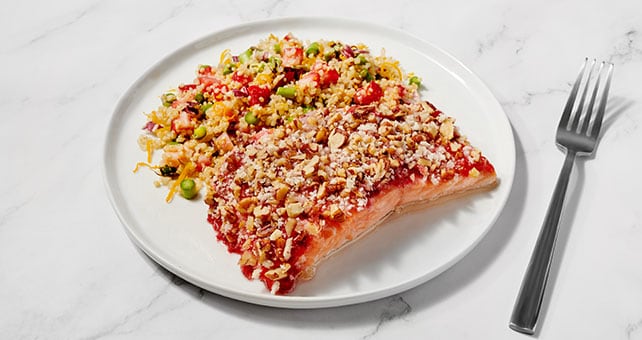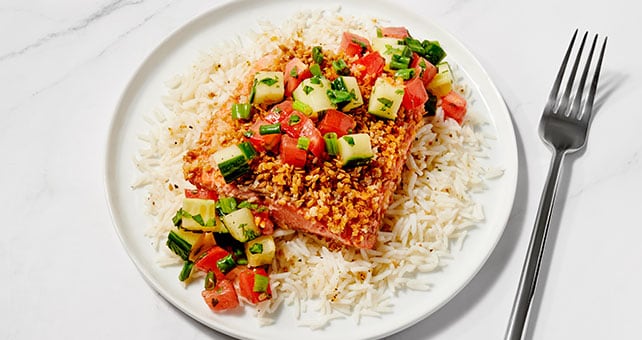Updated April 25, 2024
By clicking certain links in this article, you will leave publix.com and enter outside websites that Publix does not operate or control.
Use the MIND diet to add certain foods while cutting back on others to support better brain health. Created in 2015, the MIND (Mediterranean Intervention for Neurodegenerative Delay) diet combines elements of the DASH diet and Mediterranean diet to focus on foods that may support brain health such as green leafy vegetables, nuts, berries, beans, whole grains, fish, olive oil, poultry, and wine (no more than 1 glass per day). It also limits butter/margarine, cheese, red meat, fried food, and sweets.1
A study supported by the National Institute on Aging (part of the U.S. National Institutes of Health) found that the MIND diet reduced the incidence of Alzheimer’s disease by 53 percent among people who followed it closely and by 35 percent among those who followed it moderately. More research is needed to confirm these results; however, using this dietary pattern may help improve cognitive decline in older populations.2
Recipes.
Feed your mind.
The MIND diet is less like a meal plan and more about getting the right foods into your diet. Early research shows that moderate followers may experience benefits. Foods include:
- Six or more servings of green leafy vegetables, such as kale, collard greens, spinach, or romaine lettuce per week. Serving size: 1/2 cup of cooked vegetables or 1 cup raw vegetables.
- One serving of nonstarchy vegetables such as asparagus, broccoli, cauliflower, carrots, bell peppers, tomatoes, green beans, or mushrooms a day. Serving size: 1/2 cup cooked vegetables or 1 cup raw vegetables.
- Five or more servings of nuts weekly. Serving size: 1 ounce or 1/4 cup.
- At least two servings of berries per week. Serving size: 1 cup. Find out more about berry benefits here.
- A minimum of 4 servings of beans and legumes per week. Serving size: 1/2 cup canned or cooked beans. Follow these tips for preparing and eating beans.
- Use olive oil as your main prep and cooking oil since the diet limits butter and margarine. Use olive oil to sauté, bake, grill, or broil foods.
- At least three servings of whole grains per day. Serving size: 1 slice 100% whole wheat bread; 1/2 cup cooked brown rice, quinoa, or whole wheat pasta; or 1 cup ready-to-eat whole grain breakfast cereal. For more whole grain goodness, check out these tips.
- At least one serving of fish a week—particularly fish that are sources of the omega-3 fatty acids DHA & EPA, such as salmon, trout, oysters, crab, mussels, catfish, clams, and flounder.3 Serving size: 3-ounce cooked portion. Learn more about the benefits of seafood and omega-3s here.
- At least 2 or more servings of poultry (chicken or turkey) a week. Avoid frying, as the plan suggests keeping your fried food intake to once a week or less. Serving size: 3-ounce cooked portion.
- One glass of wine (5 ounces) a day. But if you don’t drink, it is not recommended to start.
- Foods to limit include red meat (less than 4 servings per week), fried food and fast foods (no more than once per week), butter and margarine (less than 1 tablespoon per day), cheese (no more than 1 serving per week), pastries and sweets (fewer than 5 servings per week).2

Smart starts.
Follow these tips to give yourself a strong start with the MIND diet.
- Add more greens to your meals. Have a small side salad at dinner, toss some kale into a smoothie, or stir into pasta, soups, and stews.
- Get that fish serving once a week with our delicious recipe for Flaxseed Salmon with Cucumber-Tomato Salsa. The salmon is encrusted with bread crumbs and flaxseeds, pan-seared, and served with a refreshing cucumber-tomato salsa.
- Do three servings of whole grains each day seem like a challenge? One slice of bread is one serving, so make a sandwich with two slices of 100% whole wheat bread for lunch. Add a bowl of oatmeal for breakfast and you're set. Another example: Have a bowl of whole grain cereal in the morning (one serving) and a cup of brown rice (two servings) for dinner.
- Berries can be a versatile addition for many meals. Our Pecan-Berry Salmon with Orange Quinoa Salad brings the sweet, the citrus, and the savory.
- Go meatless one night a week. Our Mediterranean-Style Protein Bowl with riced cauliflower, tofu, cucumber, carrots, and chickpeas is the perfect quick and easy meal for a summer evening.
- Sprinkle nuts over salads, soups, yogurt, and oatmeal. Or just snack on a portion—about 1/4 cup. Look for unsalted or lightly salted varieties.2
For the love of you.
Choosing how you eat is uniquely personal. It’s about your needs, your preferences, and your goals. As your wellness ally, we’re in your corner with fresh ideas, recipes, and wellness icons that make it easier to shift toward wiser food choices. It’s all about you, at your very best.
Sources
1 Pike, Alyssa. What is the MIND Diet? FoodInsight.org. January 15, 2019.
2 Bhuiyan, Nusrat Zahan, and Md. Kamrul Hasan. Prevention of Alzheimer's Disease through Diet: An Exploratory Review. PubMed Central. Last modified September 21, 2023.
3 Which Fish is the Richest in Omega-3s? Seafood Nutrition Partnership. Accessed April 5, 2021.

 You are about to leave publix.com and enter the Instacart site that they operate and control. Publix’s delivery and curbside pickup item prices are higher than item prices in physical store locations. Prices are based on data collected in store and are subject to delays and errors. Fees, tips & taxes may apply. Subject to terms & availability. Publix Liquors orders cannot be combined with grocery delivery. Drink Responsibly. Be 21. For prescription delivery, log in to your pharmacy account by using the Publix Pharmacy app or visiting
You are about to leave publix.com and enter the Instacart site that they operate and control. Publix’s delivery and curbside pickup item prices are higher than item prices in physical store locations. Prices are based on data collected in store and are subject to delays and errors. Fees, tips & taxes may apply. Subject to terms & availability. Publix Liquors orders cannot be combined with grocery delivery. Drink Responsibly. Be 21. For prescription delivery, log in to your pharmacy account by using the Publix Pharmacy app or visiting 
